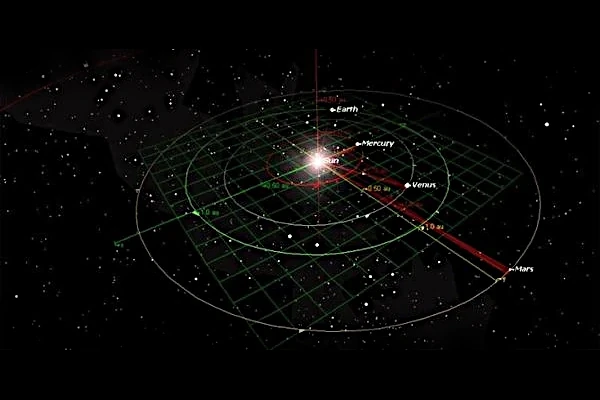
The orbital velocity of a planet is the speed at which it moves along its orbit around its star. It results from the balance between the gravitational force and the centrifugal force. The dynamic equilibrium condition for a circular orbit requires that the centripetal force \( F_c = \frac{m v^2}{r} \) compensates the gravitational force \( F_g = \frac{G M m}{r^2} \), where \( G \) is the gravitational constant, \( M \) the mass of the star, and \( r \) the orbital radius.
By equating \( F_c \) and \( F_g \), we obtain:
\( \frac{m v^2}{r} = \frac{G M m}{r^2} \)
The planetary mass \( m \) cancels out, showing that the orbital velocity does not depend on the planet’s mass:
\( v = \sqrt{\frac{G M}{r}} \)
This fundamental relation expresses the dependence of orbital velocity on the distance to the star. A planet close to the Sun (like Mercury) moves faster, while a distant planet (like Neptune) moves more slowly.
This equation illustrates the empirical laws of Johannes Kepler (1571–1630) and the gravitational theory of Isaac Newton (1643–1727). The orbital velocity decreases with the square root of the distance, following \( v \propto r^{-1/2} \). It determines the orbital period \( T \) according to Kepler’s third law: \( T^2 \propto r^3 \).
For each planet in the Solar System, the average orbital velocity can therefore be calculated from the solar mass \( M_\odot = 1.989 \times 10^{30}\, \mathrm{kg} \) and the mean orbital radius expressed in meters.
| Planet | Mean distance from the Sun (106 km) | Orbital velocity (km/s) | Sidereal period (days) |
|---|---|---|---|
| Mercury | 57.9 | 47.9 | 87.97 |
| Venus | 108.2 | 35.0 | 224.70 |
| Earth | 149.6 | 29.8 | 365.26 |
| Mars | 227.9 | 24.1 | 686.98 |
| Jupiter | 778.6 | 13.1 | 4332.6 |
| Saturn | 1433.5 | 9.7 | 10759 |
| Uranus | 2872.5 | 6.8 | 30688 |
| Neptune | 4495.1 | 5.4 | 60182 |
Source: Jet Propulsion Laboratory – Solar System Dynamics.
The equation \( v = \sqrt{\frac{G M}{r}} \) assumes a perfectly circular orbit and neglects gravitational perturbations between planets. In reality, orbits are elliptical: the speed varies with position, being higher at perihelion and lower at aphelion. This variation follows Kepler’s law of areas: the radius vector sweeps out equal areas in equal times.
The total orbital energy (kinetic + potential) of a planet in a circular orbit is:
\( E = -\frac{G M m}{2 r} \)
The negative value indicates that the planet is gravitationally bound to its star: energy \( \geq |E| \) must be supplied to escape, that is, to reach the escape velocity \( v_e = \sqrt{\frac{2 G M}{r}} \), equal to \(\sqrt{2}\) times the orbital velocity.